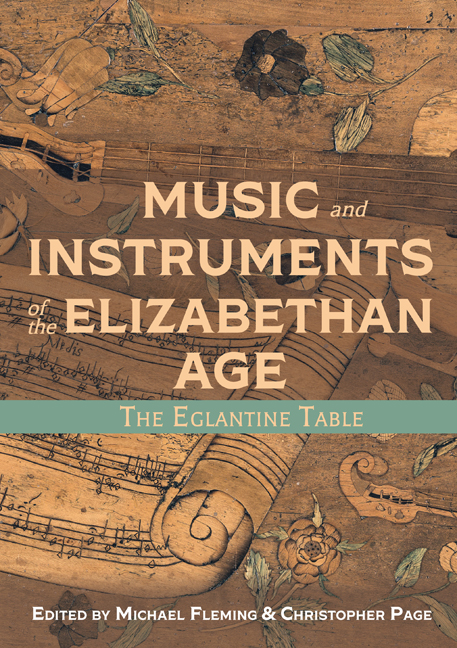Book contents
- Frontmatter
- Dedication
- Contents
- List of Illustrations
- Foreword
- Acknowledgements
- Note to the Reader
- List of Abbreviations
- Introducing the Eglantine Table
- Part I Silent Things
- Part II Music and Instruments
- Part III Broader Views of the Eglantine Table
- Appendices
- Glossary
- Bibliography
- List of Contributors
- Index
- Plate section
8 - The Bowed Instruments and Bows
Published online by Cambridge University Press: 24 March 2021
- Frontmatter
- Dedication
- Contents
- List of Illustrations
- Foreword
- Acknowledgements
- Note to the Reader
- List of Abbreviations
- Introducing the Eglantine Table
- Part I Silent Things
- Part II Music and Instruments
- Part III Broader Views of the Eglantine Table
- Appendices
- Glossary
- Bibliography
- List of Contributors
- Index
- Plate section
Summary
Three instruments with bows are depicted on the Eglantine Table (Plates 4 and 5), and they all pose the same question: is this a member of the viol family (viola da gamba) or of the violin family (viola da braccio)? The anonymous author of The praise of musicke (1586) believed that instruments had become so diverse by his day that they were harder to name than to make, so the question of whether the bowed instruments of the Table are to be called viols or violins would have seemed a cogent one to the best-informed Elizabethans, and yet our predicament is somewhat different from theirs. We seek and expect clear identifications, but it is likely that many early admirers of the Eglantine Table would have indifferently referred to the instruments with bows as viols, violins, or perhaps something else again.
To be sure, it is possible to draw up a list of characteristics that seem to distinguish viols and violins, in general terms, from one another as we review their history from the sixteenth century onwards. Such a list would associate viols (but not violins) with the use of frets, for example, and violins (but not viols) with the use of just four strings. To material criteria such as these we could add matters of repertoire and social context – as, for example, by associating viols (but not violins) with the cultured amateur and violins with the professional. Yet the mere possibility of framing such a list, which has perhaps already become somewhat puzzling, should not mislead us. These are all generalisations, liable to be called into question, or even falsified, by a passing reference in a contemporary text, a painting, an archival document or an engraving. However useful they may be at one level, they drain the colour from the rich and vigorous musical culture of bowed instruments that contemporaries knew. Even the trained musicians of the Elizabethan period, we may suspect, did not usually employ the kind of precision, associating the names of musical instruments with particular sets of diagnostic features, that a modern orchestral musician, for example, would use when speaking of violins as opposed to violas. It required the scientific revolution of the seventeenth century, and the later concern with classification in sciences such as botany and geology, for such rigorously taxonomic thinking to become instinctive.
- Type
- Chapter
- Information
- Music and Instruments of the Elizabethan AgeThe Eglantine Table, pp. 125 - 136Publisher: Boydell & BrewerPrint publication year: 2021

